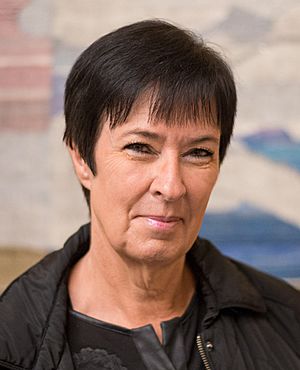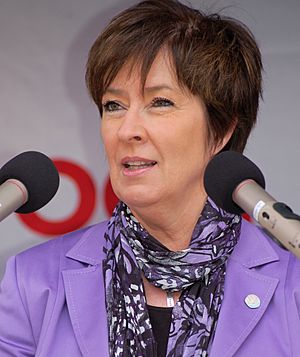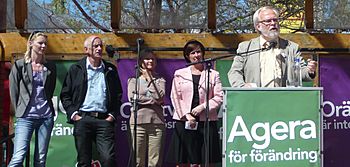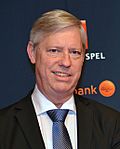Mona Sahlin facts for kids
Quick facts for kids
Mona Sahlin
|
|
|---|---|

Mona Sahlin in 2015
|
|
| Leader of the Social Democratic Party | |
| In office 17 March 2007 – 25 March 2011 |
|
| General Secretary | Marita Ulvskog Ibrahim Baylan |
| Preceded by | Göran Persson |
| Succeeded by | Håkan Juholt |
| Leader of the Opposition | |
| In office 17 March 2007 – 25 March 2011 |
|
| Monarch | Carl XVI Gustaf |
| Prime Minister | Fredrik Reinfeldt |
| Preceded by | Göran Persson |
| Succeeded by | Håkan Juholt |
| Deputy Prime Minister of Sweden | |
| In office 7 October 1994 – 16 November 1995 |
|
| Prime Minister | Ingvar Carlsson |
| Preceded by | Bengt Westerberg |
| Succeeded by | Lena Hjelm-Wallén |
| Member of the Riksdag for Stockholm County |
|
| In office 2002–2011 |
|
| In office 1982–1996 |
|
| Personal details | |
| Born |
Mona Ingeborg Andersson
9 March 1957 Sollefteå, Sweden |
| Political party | Social Democrats |
| Spouse | Bo Sahlin |
| Children | 4 |
| Signature |  |
Mona Ingeborg Sahlin (born 9 March 1957) is a Swedish politician. She was the leader of the opposition and the Swedish Social Democratic Party from 2007 to 2011.
Sahlin was a Member of Parliament for Stockholm County. She served from 1982 to 1996 and again from 2002 to 2011. She also held important roles as a minister in the Swedish government. These roles were from 1990 to 1991, 1994 to 1995, and 1998 to 2006.
Mona Sahlin was chosen as the leader of the Social Democratic Party on 17 March 2007. She took over from Göran Persson. He stepped down after his party lost the 2006 general election. Sahlin was the first woman to lead the Swedish Social Democratic Party. In 2011, she became the first leader since 1907 to leave the position without becoming Prime Minister of Sweden. Her successor, Håkan Juholt, also left the role without becoming prime minister in 2012. After her party lost the 2010 election, she announced she would step down. She officially left her role in early 2011.
Contents
Early Life and School
Mona Ingeborg Andersson was born in Sollefteå, Västernorrland County, Sweden. Her father, Hans Andersson, worked in homes that cared for young people. In the mid-1960s, her family moved to Järla in Stockholm County. They stayed there. Her father later became an advisor to former Prime Minister Ingvar Carlsson.
In 1964, when she was seven, Sahlin started the Swedish "Barbie Club". As a child, she also loved soccer and music. Sahlin sang backup for Jan Malmsjö in 1969. This was for the song to represent Sweden in the Eurovision Song Contest. The song was written by Benny Andersson and Lasse Berghagen. It came in second place.
Sahlin went to Nacka Samskola and Södra Latin in Stockholm. She finished high school in 1977. From 1976 to 1977, she was the vice chairperson of the Swedish Pupils' Association. After school, she worked for a private company. Later, she became a trade union representative for the Swedish National Union of State Employees.
Political Journey
Mona Sahlin's political journey began in 1973. She was 16 years old and joined the Swedish Social Democratic Youth League in Nacka. This was during the Vietnam War. When she was 13, Sahlin had joined a Swedish support group for the Viet Cong.
In the Swedish general election of 1982, Sahlin was elected to the Riksdag. She was the youngest member of parliament at that time. In 1990, she became the Minister for Employment. However, the Social Democrats lost the 1991 election. Sahlin then became the chairman of the Riksdag's Committee on the Labour Market. She also spoke for the Social Democrats on issues related to jobs.
From 1992 to 1994, she was the party secretary. During this time, she spoke out against government changes. She especially criticized reforms on social welfare and workers' rights. She believed these changes needed to be reversed. She left her position to join the government again in 1994. The Social Democrats had won the election. She became Minister for Gender Equality and Deputy Prime Minister.
In October 1995, a newspaper reported that Sahlin had used a government credit card for personal shopping. She was the Deputy Prime Minister then. She admitted using the card to buy groceries. She also said she had not paid some parking tickets and daycare bills on time. She later apologized. An investigation found no wrongdoing, and she paid the bills. This event was called the "Toblerone affair" because the credit card statement included Toblerone chocolate bars.
Time Away and Return to Politics
From 1996 to 1997, Sahlin worked for herself. She owned a small company and was a television reporter. In 1997, she was chosen to lead the European Council Against Racism. In 1998, she became the head of the Social Democratic youth education school Bommersvik.
Sahlin returned to national politics in 1998. The Prime Minister, Göran Persson, appointed her as a Minister without Portfolio. She worked in different ministries. From 1998 to 2002, she was in the Ministry of Industry, Employment and Communication. From 2002 to 2004, she was in the Ministry of Justice. There, she was the "Minister for Democracy and Integration". From 2004 to 2006, she was in the Ministry of Sustainable Development. She was the "Minister for Sustainable Development". In 2004, she was the minister for helping refugees settle in. She believed all refugees in Sweden should have the same rights.
Leading the Social Democratic Party
After the Social Democrats lost the 2006 election, Göran Persson retired as party leader. Mona Sahlin was considered as a possible new leader. Other candidates like Margot Wallström and Carin Jämtin had strong support. However, Wallström, Jämtin, and Ulrica Messing all decided not to run. They supported Sahlin instead. This made Mona Sahlin the main candidate. On 18 January, the party's Election Committee officially asked her to be leader, and she accepted. On 17 March, she was chosen unanimously at a special party meeting in Stockholm.
In January 2007, public support for the new government in Sweden dropped. Polls showed that the left-leaning parties had much stronger support. This gave Mona Sahlin a good chance to lead the opposition against Prime Minister Fredrik Reinfeldt. However, by April 2009, her support had decreased. A poll showed that the four-party Alliance had 50 percent voter support. Sahlin's opposition had 45.2 percent. Another poll showed that only 27 percent of Swedes trusted her leadership. In contrast, 60 percent trusted Reinfeldt.
Mona Sahlin is often seen as a moderate member of her party. Some left-wing party members did not support her for leader at first. But this criticism lessened in January 2007. The head of the Trade Union Confederation, Wanja Lundby-Wedin, fully supported Sahlin. Many powerful party groups around the country also supported her. One of her main ideas was to form the Red-Green alliance. This alliance was between the Social Democrats and the Green Party. It aimed to stop changes to the social welfare system and the sale of state-owned businesses.
In the election to the European Parliament on 7 June 2009, the Social Democratic Party received 24.41 percent of the votes. This was a small decrease from the 2004 election. This result was the lowest for the Social Democratic Party since 1921. During the election campaign, Sahlin said that if their numbers were not positive, it would be a "deep failure".
She led the Social Democratic Party in the election of September 2010. She did not succeed in replacing Fredrik Reinfeldt as Prime Minister. The Social Democrats received their lowest percentage of votes ever. However, they were still the largest party in Sweden by a small amount in 2010. She resigned as party leader on 25 March 2011. She was the second Social Democratic Party leader to resign without having served as prime minister.
In 2016, Mona Sahlin stepped down from her role as Sweden's national coordinator against violent extremism. This happened after a newspaper reported that she had given false information about her bodyguard's salary. She had written a letter stating a much higher salary to help him get a loan. She first said she paid the difference herself, but later admitted this was not true. The media compared this to the "Toblerone case" from the 1990s.
Personal Life
Mona Sahlin has one brother and two sisters. Her brother, Janne Andersson, used to be the lead singer of the pop group Japop. He now owns his own production company. Her sister Lena Ridemar is a chief of staff at the Tenants' Association.
In 1982, she married Bo Sahlin. He is also a politician. He later became the CEO of the Social Democratic media company AiP Media Produktion AB in 2006. They have three children: Jenny (born 1983), Gustav (born 1989), and Johan. Johan passed away at ten months old due to heart problems. Mona Sahlin also has another child named Ann-Sofie from a previous relationship.
See also
 In Spanish: Mona Sahlin para niños
In Spanish: Mona Sahlin para niños




